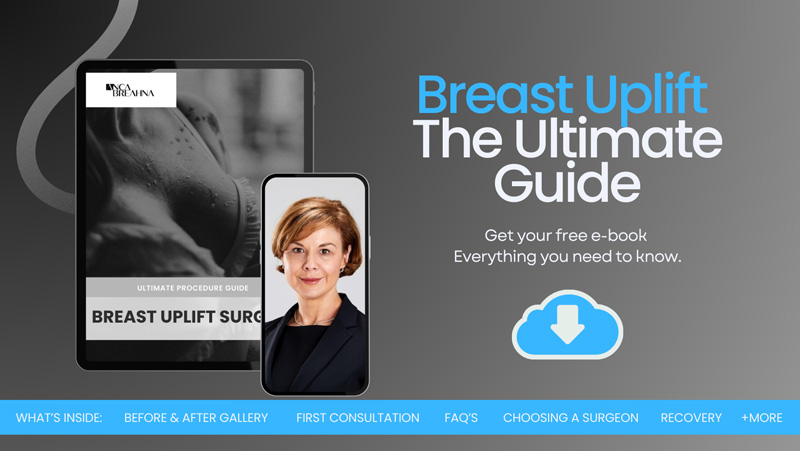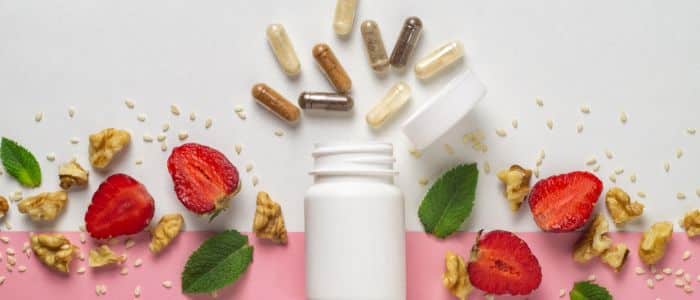
How to Minimise Bruising after Mastopexy
Breast lift surgery is increasingly sought after for aesthetic reasons. While the benefits of this procedure are manifold, encompassing enhanced breast contour and improved self-esteem, it’s not without its post-operative challenges. One of the most common and visible side effects is bruising. Bruising, while typically harmless and temporary, can cause discomfort and prolong the visual recovery process.
In this blog, Chester Consultant Plastic Surgeon Anca Breahna will discuss effective strategies to minimise bruising after breast uplift surgery, aiding in a more comfortable and swift recovery.
Download Breast Uplift Guide

Bruising After Breast Uplift Surgery
Bruising, or contusions, is the body’s natural response to trauma. In the context of breast lift surgery, the delicate tissues and blood vessels in and around the breast area are manipulated, sometimes leading to minor bleeding under the skin. This results in the typical discolouration seen on the surface – starting as a reddish mark that gradually turns bluish, purplish, or even blackish. As the bruise heals, it may change to a yellowish or greenish colour before completely resolving.
The extent and duration of bruising vary considerably among individuals. Factors such as the complexity of the surgery, the patient’s age, skin type, and overall health can influence the severity of bruising. It’s also worth noting that some degree of bruising is inevitable and is a part of the body’s healing process.
The Healing Process of Bruises
Understanding the healing timeline is crucial in setting realistic expectations post-surgery. Typically, bruising peaks within the first week of surgery and gradually fades over the following weeks. The total healing time can vary from two to three weeks for minor bruising, to a month or more for more extensive bruising. During this time, the body is actively reabsorbing the blood that has leaked into the tissues, which is what causes the change in colour of the bruise.
While the sight of bruising can be unsettling, it’s important to remember that it is a temporary and a natural part of the healing journey. In most cases, bruises are not indicative of any complications. However, if you notice any signs of infection, excessive swelling, or if the bruising does not improve over time, it is crucial to contact Anca’s team.
Factors That Can Prolong Bruising after Breast Uplift Surgery
Several factors can influence the extent and duration of bruising. Patients who are prone to bruising or bleeding, such as those with certain medical conditions or on specific medications, may experience more pronounced bruising. Lifestyle factors, including smoking and alcohol consumption, can also exacerbate bruising and slow down the healing process. Moreover, failure to adhere to post-operative care instructions, such as engaging in vigorous physical activities too soon, can worsen bruising and lead to other complications.
Strategies to Reduce Bruising after Breast Uplift
Anca recommends these strategies to minimise bruising after a mastopexy surgery:
Strategy 1: Cold Compress
One of the most effective and immediate methods to manage bruising post-surgery is the application of a cold compress. Cold therapy, also known as cryotherapy, works by constricting the blood vessels, which can significantly reduce blood flow to the affected area. This reduction in blood flow helps to minimise swelling and the size of the bruise. Furthermore, cold compresses can provide a numbing effect, offering temporary relief from pain.
How to Safely Use a Cold Compress
For optimal results, begin applying a cold compress as soon as possible after your surgery, ideally within the first 24 to 48 hours. Use a clean cloth or a commercial cold pack, wrapping it in a soft towel to protect your skin. Apply the compress to the bruised area for about 15 to 20 minutes, and then remove it for at least 20 minutes before reapplying. Continue this process several times a day for the first few days post-surgery.
Precautions and Tips
It’s important to avoid applying ice directly to the skin, as this can cause ice burns or frostbite. Additionally, do not use cold therapy for too long at a stretch, as overexposure can lead to skin damage and may impede the healing process. If you experience any discomfort, discontinue use immediately and consult your healthcare provider.
Strategy 2: Elevation
Elevation is another simple yet effective strategy to manage bruising after breast uplift surgery. By elevating the breasts above the level of your heart, gravity can assist in reducing blood flow to the area, which helps in both reducing bruising and swelling.
How to Elevate Effectively
The key to effective elevation lies in finding a comfortable position that keeps the surgical area above heart level. This can be achieved by propping up pillows under your back and arms when lying in bed or sitting in a recliner. Ensure that the elevation is gentle and does not put any strain on your neck or back.
Timing and Precautions
Elevate as much as possible during the first 48 to 72 hours post-surgery, especially when sleeping. It is crucial, however, to change positions periodically to avoid stiffness and to promote circulation in other areas of the body. Always follow Anca’s advice regarding post-operative positions and movements to avoid any strain on the surgical incisions.
Strategy 3: Arnica Montana
Arnica Montana, commonly known as Arnica, is a herb widely used for its anti-inflammatory and pain-relieving properties. It is often recommended in homeopathic and alternative medicine circles for the reduction of bruising and swelling.
Arnica works by stimulating the flow of white blood cells, which process congested blood, and by dispersing trapped fluids from bruised tissue, muscles, and joints. This action can help reduce the swelling and pain associated with bruises.
Using Arnica Effectively
Arnica is available in various forms, including creams, gels, ointments, and oral pellets. For breast lift surgery recovery, topical application on the bruised areas can be particularly beneficial. However, it is critical to ensure that the skin is intact and that Arnica is not applied on open wounds or directly on the surgical incisions. If you opt for oral Arnica, it is usually taken in the form of small pellets that dissolve under the tongue.
Precautions and Recommendations
While Arnica is generally considered safe, it’s important to consult your Anca before using it, especially if you are taking other medications or have underlying health conditions. Arnica should be used as directed, and it’s advisable to follow the dosage recommendations on the product label or those given by your surgeon. Overuse or misuse of Arnica can lead to side effects, so adherence to guidelines is crucial.
Strategy 4: Avoiding Certain Medications and Supplements
Certain medications and supplements can increase the risk of bruising and bleeding, particularly after surgery. This is because they can affect blood clotting mechanisms or increase the fragility of blood vessels.
Medications and Supplements to Avoid
Before and after your breast lift surgery, it’s essential to avoid certain medications and supplements known for their blood-thinning properties. Common examples include aspirin, non-steroidal anti-inflammatory drugs (NSAIDs) like ibuprofen, and certain herbal supplements such as ginkgo biloba, garlic, and fish oil. Even over-the-counter medications and supplements can have a significant impact, so it’s crucial to review all your medications and supplements with your healthcare provider.
Safe Alternatives and Precautions
Your surgeon may recommend safer alternatives for pain relief and supplementation. For instance, acetaminophen can often be used as a substitute for pain relief without the blood-thinning effects. Always follow the guidance of your surgeon regarding medication management pre- and post-surgery to ensure optimal healing and to minimise bruising.
Strategy 5: Gentle Exercises
While strenuous activity and heavy lifting should be avoided after breast lift surgery, gentle exercises can be beneficial. These exercises help in promoting blood circulation, reducing swelling, and preventing blood clots — all of which can assist in minimizing bruising after breast uplift procedures.
Types of Gentle Exercises
Gentle exercises can include light walking or simple arm movements, as advised by your surgeon. The key is to keep the movements light and avoid any activity that strains the chest area or surgical incisions. These precautions also help reduce discomfort and visible bruising after breast uplift surgery. Start with short durations and gradually increase as recommended.
Timing and Guidelines
It’s generally advised to start light walking as soon as you feel comfortable post-surgery, often within a day or two. However, any specific exercises, especially those involving arm movements, should only be started after getting a go-ahead from your surgeon. Always follow the specific guidelines provided by Anca, as she will tailor the advice based on your individual surgery and recovery status.
Strategy 6: Compression Garments
Compression garments are specially designed to support the healing process after breast lift surgery. They apply gentle, consistent pressure to the surgical area, which can help reduce swelling and bruising.
Benefits of Using Compression Garments
By wearing compression garments, you can help keep the surgical area stable, which not only aids in reducing bruising but also helps in contouring and shaping the breasts as they heal. Additionally, these garments can provide comfort and support, making the recovery period more manageable.
Choosing the Right Compression Garment
It’s essential to use the compression garment recommended or provided by your surgeon, as it will be specifically suited for your type of surgery and body shape. These garments should fit snugly but not be so tight as to cause discomfort or impede circulation.
Usage Guidelines
Typically, you will be required to wear the compression garment continuously for several weeks, except when showering. Anca will give you specific instructions on how long and how often to wear it. It’s important to follow these instructions carefully to maximise the benefits of the garment.
Strategy 7: Adequate Hydration
Hydration plays a pivotal role in the recovery process after any surgery, including breast lift procedures. Adequate fluid intake is essential for maintaining healthy circulation and aiding in the body’s natural healing processes, particularly in managing bruising after breast uplift surgery.
When you are well-hydrated, your blood maintains a proper consistency, allowing it to flow more easily and reducing the risk of pooling, which can contribute to bruising. Hydration also helps in the efficient removal of waste products from the body, which is crucial in the healing phase.
Tips for Staying Hydrated
- Water Intake: Aim to drink at least 8-10 glasses of water a day. Keeping a water bottle handy can serve as a constant reminder
- Limit Dehydrating Beverages: Reduce the intake of caffeine and alcohol, as they can contribute to dehydration
- Incorporate Hydrating Foods: Foods with high water content, such as cucumbers, watermelon, and strawberries, can also contribute to your overall fluid intake
Monitoring Your Hydration Levels
Pay attention to signs of dehydration, such as dark urine, dry mouth, and fatigue. If you experience these symptoms, increase your fluid intake and consult with your medical team.
Strategy 8: Nutritional Support
Proper nutrition is crucial for wound healing and can significantly impact the recovery process after breast lift surgery. Certain nutrients play a vital role in repairing tissue, reducing inflammation, and strengthening the immune system.
Foods to Include
- Protein-Rich Foods: Protein is essential for tissue repair. Include lean meats, fish, eggs, dairy products, and plant-based proteins like beans and lentils in your diet
- Vitamin C and E: These vitamins are known for their role in wound healing and immune function. Citrus fruits, berries, nuts, and green leafy vegetables are excellent sources
- Omega-3 Fatty Acids: Found in fish, flaxseeds, and walnuts, omega-3 fatty acids can help reduce inflammation
Foods to Avoid
- High-Sodium Foods: Excessive salt can lead to swelling and should be limited
- Processed and Sugary Foods: These can impair the immune system and should be consumed in moderation
Strategy 9: Avoiding Alcohol and Smoking
Both alcohol and smoking can have profound negative impacts on the recovery process following surgery. Understanding these effects is crucial in planning for a smooth recovery.
Impact of Alcohol
- Increases Bleeding: Alcohol can thin the blood, increasing the risk of bleeding and subsequent bruising
- Dehydration: Alcohol consumption can lead to dehydration, which impairs healing
- Interferes with Medications: Alcohol can interact adversely with pain medications and antibiotics
Impact of Smoking
- Reduces Blood Flow: Nicotine causes blood vessels to constrict, reducing the flow of oxygen-rich blood to the healing tissues
- Impairs Immune Response: Smoking can weaken the immune system, increasing the risk of infection and delaying healing
Recommendations for Avoiding Alcohol and Smoking
- Pre-Surgery Abstinence: It’s advisable to abstain from alcohol and smoking for at least a week before surgery
- Post-Surgery Abstinence: Continue to avoid alcohol and smoking for a minimum of 4-6 weeks post-surgery, or as recommended by your surgeon
- Seek Support if Needed: If you find it challenging to abstain, consider seeking support from healthcare professionals. There are numerous resources and programs available to assist with quitting smoking and managing alcohol consumption
Strategy 10: Proper Wound Care
Proper wound care is crucial for preventing infection, promoting healing, and minimizing scarring and bruising after breast lift surgery. Managing bruising after breast lift procedures is an important part of the recovery process, as it can impact both comfort and cosmetic results. Efficient wound care not only aids in quicker recovery but also ensures the aesthetic outcomes of the surgery are as desired.
Guidelines for Wound Care
- Follow Surgeon’s Instructions: Adhere strictly to the wound care instructions provided by your surgeon. These instructions are tailored to the type of surgery performed and your specific needs
- Keeping the Area Clean: Gently clean the incision area as directed, usually with mild soap and water. Avoid applying harsh chemicals or alcohol-based products directly on the wounds
- Dressing Changes: Change dressings as recommended. This keeps the area clean and free from potential contaminants
- Observing the Wound: Regularly check the wound for signs of infection, such as increased redness, swelling, or a discharge. Report any concerns to Anca’s team immediately
- Avoiding Direct Sun Exposure: Protect the healing wounds from the sun, as UV rays can darken scars. Use protective clothing or a recommended sunscreen once the wounds are sufficiently healed
Things to Avoid
- Don’t Soak the Wound: Avoid baths, swimming pools, or hot tubs until your surgeon gives you the go-ahead
- Avoiding Certain Products: Refrain from applying lotions, creams, or scar treatments without your surgeon’s approval
FAQs about Recovery after Breast Uplift Surgery
How long does it typically take for bruising to completely disappear after a breast lift?
- The duration of bruising after a breast lift varies among individuals, but typically, most bruising will significantly diminish within 2-3 weeks. However, complete resolution of bruising may take up to a month or longer in some cases. The healing process depends on several factors, including the individual’s healing capacity, the extent of surgery, and adherence to post-operative care instructions.
Can I wear a regular bra during my recovery period?
- It’s generally recommended to avoid regular bras during the initial recovery period. Anca usually advises wearing specific post-surgical or compression bras. These bras are designed to provide adequate support without putting undue pressure on the surgical sites. The timeline for when you can start wearing regular bras again varies, and it’s best to follow your surgeon’s advice on this matter.
Is it normal to feel numbness in the breast area after a lift?
- Yes, it’s quite common to experience some numbness or altered sensation in the breast area after a lift. This occurs due to the disruption of nerve endings during surgery. In most cases, this numbness is temporary and sensation returns gradually over time. However, it may take several months for sensation to fully return, and in rare cases, some changes in sensation may be permanent.
Are there any specific signs of complication I should be vigilant about post-surgery?
- Yes, while most recoveries are uneventful, it’s important to be aware of signs that might indicate a complication. These include severe or increasing pain, signs of infection like fever or pus from the incision sites, excessive swelling or redness, and any discharge or unpleasant odour from the surgical area. If you experience any of these symptoms, contact Anca’s team immediately.
How soon can I return to work after undergoing a breast lift?
- The time frame for returning to work depends on the nature of your job and how your body is healing. For desk jobs or work that involves minimal physical activity, many patients can return within 1-2 weeks. However, if your job involves heavy lifting or strenuous activity, you may need to wait longer, often up to several weeks. Always consult with your surgeon before returning to work, especially if your job is physically demanding.
Further Reading about Breast Lift Surgery with Chester Consultant Plastic Surgeon Anca Breahna
- Read more about How to Fix Saggy Breasts – Breast Uplift, Breast Implants or Both
- Read more about When Can I Exercise After Breast Uplift Surgery?
- Read more about What Are the Benefits of a Breast Lift with Implants?
- Read more about How to Get Firmer Breasts
- Read more about Breasts after Weight Loss
- Read more about Solutions for Saggy Breasts
- Read more about Internal Bra – A More Durable Breast Uplift Technique
- Read more about Breast Lift and Nipple Sensitivity
- Read more about Breast Uplift and the “Pencil Test” for Breasts
Medical References about Recovery after Breast Lift Surgery
- Breast lift – Mayo Clinic
- Breast Uplift (Mastopexy) – BAAPS
- Breast Lift (Mastopexy): Surgery & Recovery – Cleveland Clinic
- Subacute Arterial Bleeding After Simultaneous Mastopexy and Breast Augmentation with Implants
- Hematoma After Non-Oncologic Breast Procedures


 Ms Anca Breahna, PhD, MSc, FEBOPRAS, FRCS (Plast) is a highly regarded Consultant Plastic Surgeon specialising in the field of Aesthetic and Reconstructive Plastic Surgery. Anca performs a range of
Ms Anca Breahna, PhD, MSc, FEBOPRAS, FRCS (Plast) is a highly regarded Consultant Plastic Surgeon specialising in the field of Aesthetic and Reconstructive Plastic Surgery. Anca performs a range of 